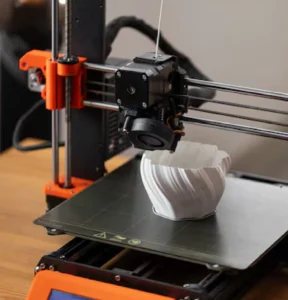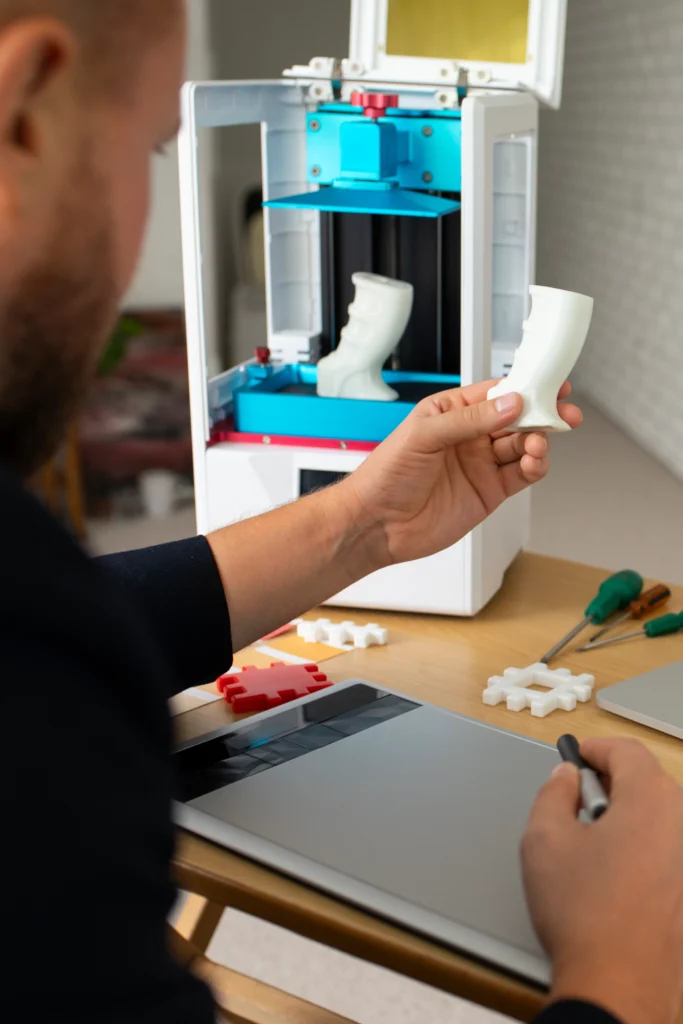Household 3D Printer: Revolutionizing DIY and Everyday Innovation

In today’s fast-paced world, innovation is no longer confined to large industries or factories. With the advent of household 3D printers, anyone can bring their creative ideas to life right from the comfort of their home. These compact devices are transforming the way we approach everyday tasks, offering personalized solutions, cost-effective manufacturing, and a deeper connection to technology.
This comprehensive guide will delve into everything you need to know about household 3D printers, their applications, costs, challenges, and how they’re shaping the future, especially in India. From understanding how they work to exploring advanced applications, this blog is your ultimate resource for diving into the world of household 3D printing.
Table of Contents
- What is a Household 3D Printer?
- How Do Household 3D Printers Work?
- Why are Household 3D Printers Gaining Popularity in India?
- Benefits of Owning a Household 3D Printer
- Comprehensive Guide to Materials Used in Household 3D Printing
- Popular Household 3D Printer Models Available in India
- Cost Analysis of Household 3D Printers and Printing Materials
- Real-Life Applications of Household 3D Printers in Indian Homes
- Common Challenges and How to Overcome Them
- The Future of Household 3D Printing in India
- Expert Tips for Beginners to Get Started with Household 3D Printing
- Top FAQs About Household 3D Printers
- Mastering 3D Printing with Kikstaart Edu’s Programs
1. What is a Household 3D Printer?
A household 3D printer is a personal 3D printer designed for non-industrial use. It allows users to print three-dimensional objects layer by layer, turning digital designs into tangible items. These devices are smaller, more affordable, and more user-friendly than their industrial counterparts, making them ideal for hobbyists, DIY enthusiasts, and families.
Key Features:
- Compact and portable design.
- Cost-effective and energy-efficient.
- Compatibility with beginner-friendly materials like PLA.
- Simple operation with intuitive software interfaces.
Use Cases:
- Printing replacement parts for appliances.
- Creating personalized gifts.
- Building prototypes for inventions.
- Educational models for students.
2. How Do Household 3D Printers Work?
The functioning of a household 3D printer is based on additive manufacturing, where objects are created by depositing material layer by layer.
Workflow:
Design:
- Use 3D modeling software like Fusion 360 or download pre-made designs from repositories such as Thingiverse.
Slicing:
- The design is converted into a layer-by-layer instruction file using slicing software like Cura.
Printing:
- The printer extrudes melted filament through a nozzle or cures resin with a laser to create the object.
Post-Processing:
- Clean up the printed item by removing supports and smoothing surfaces.
3. Why are Household 3D Printers Gaining Popularity in India?
The growing demand for household 3D printers in India is driven by:
- Affordability: Entry-level models starting at ₹15,000 make them accessible to a wider audience.
- DIY Movement: An increase in DIY culture, fueled by makerspaces and online tutorials.
- Education: Schools adopting 3D printing for STEM (Science, Technology, Engineering, Mathematics) learning.
- Start-Up Boom: Entrepreneurs using 3D printers for prototyping and production.
4. Benefits of Owning a Household 3D Printer
- Cost Savings: Print customized objects, eliminating the need to buy mass-produced items.
- Convenience: Quickly produce tools, replacement parts, or prototypes without leaving home.
- Creativity: Explore new hobbies and create unique designs.
- Sustainability: Minimize waste by printing on demand and recycling materials.
- Skill Development: Enhance technical skills in CAD design and manufacturing.

5. Comprehensive Guide to Materials Used in Household 3D Printing
Different materials serve different purposes in household 3D printing.
Popular Materials:
| Material | Properties | Applications |
|---|---|---|
| PLA (Polylactic Acid) | Biodegradable, easy to use | Decorative items, prototypes |
| ABS (Acrylonitrile Butadiene Styrene) | Durable, heat-resistant | Tools, functional parts |
| PETG (Polyethylene Terephthalate Glycol) | Flexible, strong | Food-safe containers, mechanical parts |
| Resin | High-detail, brittle | Miniatures, jewelry |
| Wood/Metal Composites | Aesthetic, specialty | Artistic designs, figurines |
6. Popular Household 3D Printer Models Available in India
Entry-Level Models (₹15,000 – ₹30,000):
- Creality Ender 3 V2: Best for beginners.
- Anycubic i3 Mega: Affordable and versatile.
Mid-Range Models (₹30,000 – ₹60,000):
- Prusa Mini: Compact and reliable.
- FlashForge Finder: Family-friendly interface.
Premium Models (₹60,000 and above):
- Elegoo Mars 3: Excellent for resin printing.
- Ultimaker S3: Professional-grade precision.
7. Cost Analysis of Household 3D Printers and Printing Materials
Printer Costs:
- Entry-Level: ₹15,000 – ₹30,000
- Mid-Range: ₹30,000 – ₹60,000
- Premium: ₹60,000+
Material Costs:
- PLA Filament: ₹1,000 – ₹2,500 per kg
- Resin: ₹3,000 – ₹6,000 per liter
8. Real-Life Applications of Household 3D Printers in Indian Homes
Everyday Uses:
- Kitchen tools like spatulas and molds.
- Customized phone cases or organizers.
Educational Applications:
- Math models (e.g., geometric shapes).
- Science kits and prototypes.
Small Business Solutions:
- Prototyping new products.
- Printing packaging prototypes.
9. Common Challenges and How to Overcome Them
- Learning Curve: Start with pre-made designs and work up to custom CAD projects.
- Print Failures: Use proper slicing settings and keep the printer well-maintained.
- Material Issues: Store materials in dry conditions to prevent moisture-related problems.
10. The Future of Household 3D Printing in India
Predictions:
- Lower Costs: Advances in technology will make household 3D printers more affordable.
- Smart Materials: Eco-friendly and multi-functional materials will become mainstream.
- Widespread Adoption: More Indian households will use 3D printers for everyday tasks.
11. Expert Tips for Beginners to Get Started
- Choose an entry-level printer like Creality Ender 3 V2.
- Start with simple projects and PLA filament.
- Learn from online communities and courses.

12. Top FAQs About Household 3D Printers
General Questions
1. What is a household 3D printer?
A household 3D printer is a compact, user-friendly device designed for personal use, allowing individuals to create three-dimensional objects layer by layer from digital designs.
2. How is a household 3D printer different from an industrial 3D printer?
Household 3D printers are smaller, more affordable, and designed for non-industrial use, while industrial printers are larger, faster, and used for large-scale production.
3. What types of objects can I create with a household 3D printer?
You can print a wide range of items, including tools, toys, phone cases, replacement parts, decorative items, and prototypes.
4. How long does it take to print an object?
Print times depend on the size and complexity of the object. Small objects may take 30 minutes, while larger or intricate designs can take several hours.
5. Is 3D printing safe for home use?
Yes, household 3D printers are safe if used properly. Ensure proper ventilation, handle materials like resin carefully, and follow manufacturer guidelines.
Technical Questions
6. What is the basic workflow of a 3D printer?
The workflow includes designing a model (or downloading one), slicing it into layers using software, and then printing the object.
7. Do household 3D printers require technical expertise?
Not necessarily. Many models are beginner-friendly, with simple software and guides. With practice, even novices can master them.
8. What maintenance does a 3D printer require?
Regular maintenance includes cleaning the nozzle, leveling the print bed, replacing worn-out parts, and keeping materials dry.
9. What software do I need for 3D printing?
Popular software includes Fusion 360, TinkerCAD, Blender (for designing), and Cura (for slicing).
10. What is slicing in 3D printing?
Slicing is the process of converting a 3D model into printable layers using slicing software like Cura or PrusaSlicer.
—
Material Questions
11. What materials can household 3D printers use?
Common materials include PLA, ABS, PETG, resin, and composite materials like wood or metal-infused filaments.
12. Which material is best for beginners?
PLA is recommended for beginners due to its ease of use, affordability, and environmental friendliness.
13. How much does 3D printing material cost?
PLA filament costs around ₹1,000–₹2,500 per kg, while resin can cost ₹3,000–₹6,000 per liter.
14. Can I recycle unused or failed prints?
Yes, failed prints and leftover material can often be recycled into new filaments using specialized devices like filament recyclers.
15. Is 3D printing eco-friendly?
It can be, especially when using biodegradable materials like PLA. However, managing waste and energy usage is essential.
Cost and Investment Questions
16. What is the cost of a household 3D printer in India?
Prices range from ₹15,000 for entry-level models to ₹1,00,000+ for premium models.
17. What is the long-term cost of using a 3D printer?
Long-term costs include filament, electricity, and occasional part replacements, making it cost-effective for frequent use.
18. Are household 3D printers worth the investment?
Yes, especially for DIY enthusiasts, small businesses, and families who can save on manufacturing and create customized items.
19. Do I need to pay for 3D design files?
Many design files are free on platforms like Thingiverse, but premium designs may require payment.
20. Can I save money by 3D printing items instead of buying them?
Yes, for many items, especially custom designs or replacement parts, 3D printing can be more economical.
Practical Applications
21. Can I print food-safe items with a household 3D printer?
Yes, with food-safe materials like PETG and proper cleaning. Use a dedicated nozzle for food-safe projects.
22. What are some fun projects for beginners?
Keychains, phone stands, coasters, and small figurines are great starter projects.
23. Can I repair broken household items with 3D printing?
Absolutely! Many users print replacement parts for appliances or tools to save money and time.
24. How do I use 3D printing for educational purposes?
Create models for science experiments, math geometry, or historical artifacts for hands-on learning.
25. Can I run a small business with a household 3D printer?
Yes, many entrepreneurs use 3D printers to create and sell custom products like jewelry, home decor, and prototypes.
Future and Trends
26. What is the future of household 3D printing in India?
Household 3D printers are expected to become more affordable and widespread, driven by innovation and government initiatives supporting STEM education.
27. Will household 3D printers become mainstream?
As prices drop and usability improves, 3D printers will likely become as common as traditional printers in homes.
28. Are there smart household 3D printers with automation?
Yes, newer models feature Wi-Fi connectivity, smart sensors, and auto-leveling for improved convenience.
Troubleshooting
29. Why does my print fail or look messy?
Common issues include an unlevel bed, incorrect slicer settings, or clogged nozzles. Adjust settings and maintain the printer regularly.
30. What should I do if my filament gets stuck?
Heat the nozzle to remove the filament carefully, and always unload the filament after use to avoid jams.
13. Mastering 3D Printing with Kikstaart Edu’s Programs
Kikstaart Edu offers industry-relevant training in 3D printing through their 6-Month CAD Modelling and 3D Printing Diploma and 3-Month Short-Term Course. With state approvals and hybrid learning options, these courses equip students with skills in:
- Fusion 360 and SolidWorks.
- Slicing and prototyping techniques.
- Advanced applications like part assembly and visualization.
Conclusion
The household 3D printer is a gateway to creativity, innovation, and self-reliance. As the technology continues to evolve, its role in Indian homes will only grow. Whether you’re a beginner or an enthusiast, now is the perfect time to explore the endless possibilities of 3D printing.
Get started today with Kikstaart Edu’s expert courses and turn your 3D printing dreams into reality!
